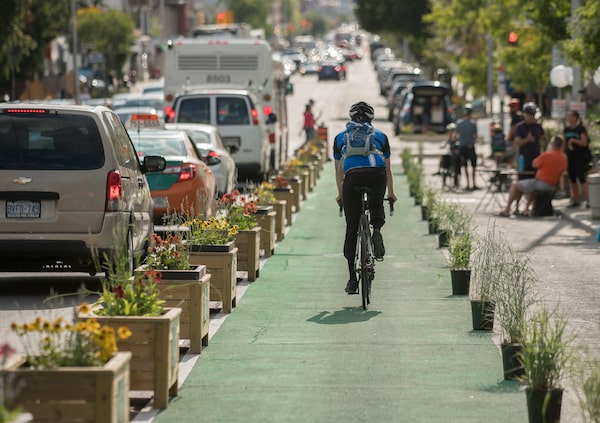
A cyclist rides down a bike lane normally occupied by traffic on Danforth Avenue between Woodbine and Woodmount Avenues during an 8 80 Cities pop-up street makeover in Toronto, Ont. on Friday, August 23, 2019. In cities in which many people take transit, the recovery from COVID-19 will almost certainly be disastrous for transportation.J.P. MOCZULSKI
Carmageddon is coming. In cities in which many people take transit, the recovery from COVID-19 will almost certainly be disastrous for transportation. As some people fear infection and move to cars, roads will be overwhelmed. In Toronto, it’s going to be bad. Before COVID, the TTC alone moved about 1.5 million people each workday. If even a quarter of them start commuting by car, the city will grind to a miserable halt in every rush hour.
This demands quick and decisive action to get people out of vehicles, the kind of policies that Paris, London and Milan have been pursuing: above all, creating bicycle infrastructure.
Downtown councillors Joe Cressy and Mike Layton are suggesting a cycling network across the city, and a staff report will go to city council early this week on the same subject. The initial Cressy-Layton proposal is for a protected bike lane along Avenue Road and University Avenue, from Davenport to downtown. It’s smart: It would allow some people a fresh-air alternative to the subway, especially in reaching the six downtown hospitals.
One way to mitigate the risk of COVID-19 “is to create opportunities for safe active transportation,” Mr. Cressy told me, “to create a safety valve for public transit.”
He and Mr. Layton are right. Cycling is an important means of transportation during a pandemic. It’s open-air, inexpensive and uses relatively little road space. A vehicle lane can move 500 to 1,000 cars an hour; a bicycle lane, upward of 2,000. And if you build a proper network of infrastructure that makes people feel safe, they will use it.
Anyone who takes transit deserves to have that option. This is why the city should be creating a network for active transportation across Toronto. Major suburban arterial roads (which are all much too wide, anyway) should be redesigned; people should have the freedom to get off crowded buses, and onto bikes, scooters or e-bikes, as easily as possible.
There’s a danger that none of this will happen. Toronto Mayor John Tory has made statements, typical for him, about finding the middle road and doing something “sensible.” But the range of acceptable opinion is absurdly small. Mr. Cressy’s and Mr. Layton’s proposal, which is modest by global standards, might be the most ambitious idea in play.
Meanwhile, the anti-bike faction has been vocal. Deputy Mayor Stephen Holyday has been sounding the alarm. “I'm particularly concerned about the idea that we would deactivate travel lanes and dedicate them exclusively to bicycle infrastructure,” the Etobicoke councillor told me.
His words suggest that bicycling is not “travel.” And his underlying assumption, he said, is that “it’s not likely that a significant number of people will move to cycling.” Taking away car lanes would create “delays for people coming into downtown, from the suburbs and outside the city.”
Yet he had zero data to support this argument. Did he know long those delays might be? “We don’t have that information.” Did he know how many people drive along University Avenue in rush hour, or how long it takes them to do so? Also no.
The numbers are tiny. City traffic counts show roughly 1,600 drivers heading north at the peak of evening rush hour, at the busy intersection of College Street and University. And because traffic engineers assume a lane can carry 500 or more cars an hour, the four northbound lanes are actually underused.
Surprised? The truth is that a motor vehicle, with one person in it, is a deeply inefficient way to move people around. Cars take up a lot of room. Mr. Holyday’s criticism – “I’m trying to bring a practical lens,” he said – reflects a worldview that refuses to account for geometry.
But what if 1,600 people really did have to slow down a bit, so that tens of thousands of hospital employees have the ability to safely bike to work in a pandemic? Along with others of the 450,000 people who work downtown? That’s a reasonable trade-off. Sensible, you might say, as a first step to a wider network.
Or we could let vehicles choke the city to death. There’s not much time left to decide.
Sign up for the Coronavirus Update newsletter to read the day’s essential coronavirus news, features and explainers written by Globe reporters and editors.
 Alex Bozikovic
Alex Bozikovic